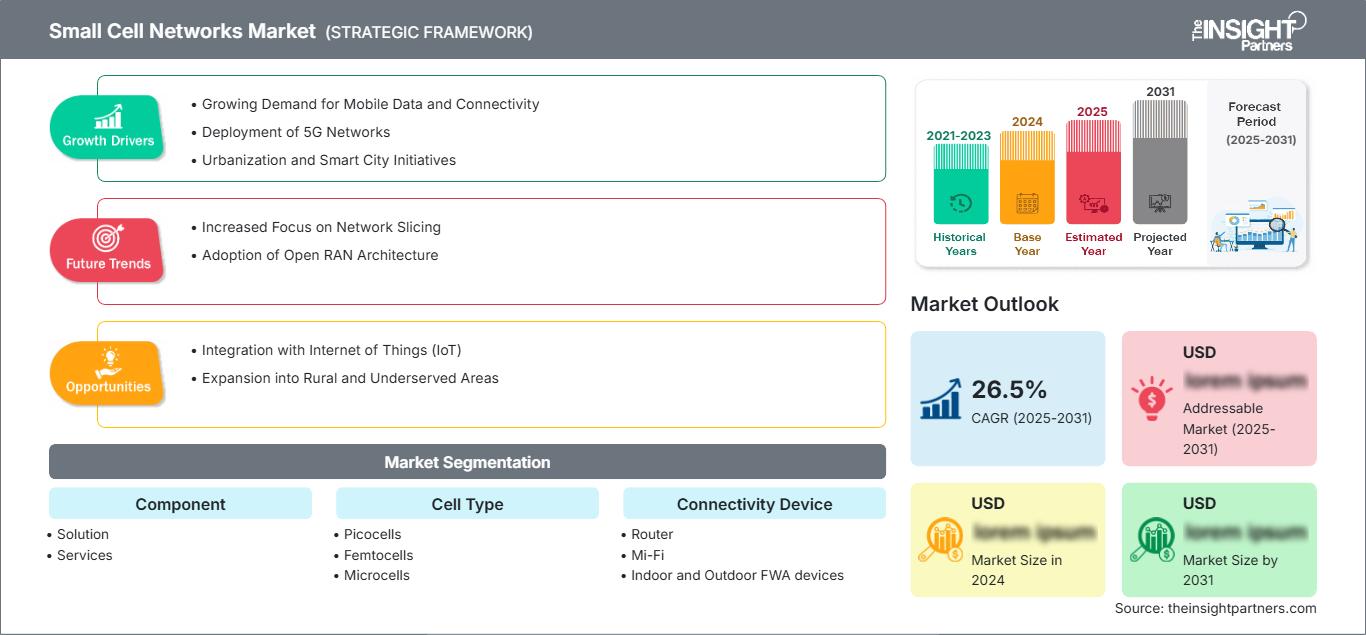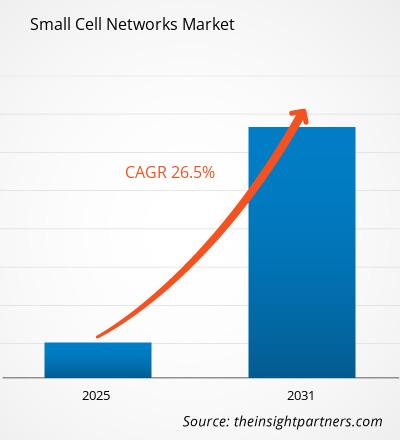Le marché des réseaux de petites cellules devrait enregistrer un TCAC de 26,5 % entre 2025 et 2031, avec une taille de marché passant de XX millions de dollars américains en 2024 à XX millions de dollars américains d'ici 2031.
Le rapport est segmenté par composant [solution, services (conseil, déploiement et intégration, formation, support et maintenance)] ; type de cellule (picocellules, femtocellules, microcellules, MetroCell) ; appareil de connectivité (routeur, Mi-Fi, appareils FWA intérieurs et extérieurs, passerelle, autres) ; déploiement (extérieur, intérieur) ; utilisateurs finaux (résidentiel, commercial, industriel). L'analyse mondiale est ensuite ventilée au niveau régional et par principaux pays. Le rapport offre la valeur en USD pour l'analyse et les segments ci-dessus.
Objectif du rapport
Le rapport sur le marché des réseaux de petites cellules de The Insight Partners vise à décrire le paysage actuel et la croissance future, les principaux facteurs moteurs, les défis et les opportunités. Cela fournira des informations à diverses parties prenantes commerciales, telles que :
- Fournisseurs/fabricants de technologie : pour comprendre l’évolution de la dynamique du marché et connaître les opportunités de croissance potentielles, leur permettant de prendre des décisions stratégiques éclairées.
- Investisseurs : pour effectuer une analyse complète des tendances concernant le taux de croissance du marché, les projections financières du marché et les opportunités qui existent tout au long de la chaîne de valeur.
- Organismes de réglementation : pour réglementer les politiques et surveiller les activités du marché dans le but de minimiser les abus, de préserver la confiance des investisseurs et de maintenir l’intégrité et la stabilité du marché.
Composant de segmentation du marché des réseaux de petites cellules
- Solution
- Services
Type de cellule
- Picocellules
- Femtocellules
- Microcellules
- MetroCell
Dispositif de connectivité
- Routeur
- Mi-Fi
- Dispositifs FWA intérieurs et extérieurs
- Passerelle
Déploiement
- Extérieur
- Intérieur
Utilisateurs finaux
- Résidentiel
- Commercial
- Industriel
Vous bénéficierez d’une personnalisation sur n’importe quel rapport - gratuitement - y compris des parties de ce rapport, ou une analyse au niveau du pays, un pack de données Excel, ainsi que de profiter d’offres exceptionnelles et de réductions pour les start-ups et les universités
Marché des réseaux de petites cellules: Perspectives stratégiques

-
Obtenez les principales tendances clés du marché de ce rapport.Cet échantillon GRATUIT comprendra une analyse de données, allant des tendances du marché aux estimations et prévisions.
Moteurs de croissance du marché des réseaux de petites cellules
- Demande croissante en données mobiles et connectivité : La dépendance croissante aux appareils mobiles et l’augmentation conséquente du trafic de données mobiles sont des moteurs majeurs du marché des réseaux de petites cellules. Alors que les consommateurs et les entreprises exigent une connectivité plus rapide et plus fiable, les réseaux macrocellulaires traditionnels peinent à répondre à ces besoins, en particulier dans les zones urbaines densément peuplées. Les petites cellules, qui améliorent la capacité et la couverture du réseau, sont essentielles pour fournir des services de données à haut débit, ce qui en fait une solution attrayante pour les opérateurs mobiles qui cherchent à améliorer l’expérience et la satisfaction des utilisateurs.
- Déploiement des réseaux 5G : Le déploiement continu de la technologie 5G est un moteur important pour le marché des réseaux de petites cellules. Les petites cellules font partie intégrante de l’infrastructure 5G, fournissant la densification nécessaire pour prendre en charge les bandes de fréquences élevées et des débits de données améliorés. Alors que les entreprises de télécommunications investissent massivement dans le déploiement de la 5G pour répondre aux attentes des consommateurs en matière de connectivité plus rapide, la demande de solutions de petites cellules continuera de croître. Cette tendance devrait accélérer l'adoption des petites cellules comme composant clé des réseaux sans fil de nouvelle génération.
- Initiatives d'urbanisation et de ville intelligente : L'urbanisation entraîne une augmentation de la densité de population dans les villes, ce qui crée un besoin urgent de connectivité sans fil améliorée. Les réseaux de petites cellules jouent un rôle crucial dans les initiatives de ville intelligente en fournissant l'infrastructure nécessaire aux appareils de l'Internet des objets (IoT), à la gestion intelligente du trafic et aux services de sécurité publique améliorés. Alors que les villes s'efforcent de devenir plus intelligentes et plus connectées, l'adoption des réseaux de petites cellules devrait augmenter, stimulant la croissance du marché et offrant des opportunités d'innovation dans les télécommunications urbaines.
Tendances futures du marché des réseaux de petites cellules
- Focalisation accrue sur le découpage de réseau : Une tendance importante sur le marché des réseaux de petites cellules est l'importance croissante accordée au découpage de réseau, en particulier dans le contexte de la technologie 5G. Le découpage de réseau permet aux opérateurs de créer plusieurs réseaux virtuels sur une seule infrastructure physique, chacun adapté à des cas d'utilisation et des accords de niveau de service spécifiques. Cette capacité améliore l'efficacité et la flexibilité des déploiements de petites cellules, permettant aux opérateurs de mieux gérer les ressources et de fournir des services personnalisés à divers segments d'utilisateurs, tels que les entreprises, les consommateurs et les applications IoT.
- Adoption de l'architecture Open RAN : L'évolution vers l'architecture Open RAN (Radio Access Network) est une tendance importante qui impacte le marché des réseaux de petites cellules. L'Open RAN favorise l'interopérabilité et la diversité des fournisseurs en permettant aux opérateurs de combiner des composants de différents fournisseurs. Cette tendance encourage l'innovation et réduit les coûts, permettant ainsi aux petits acteurs d'entrer sur le marché. À mesure que les entreprises de télécommunications adoptent les principes de l'Open RAN, le déploiement de petites cellules deviendra plus flexible et rentable, favorisant un paysage concurrentiel et accélérant la croissance du marché.
Opportunités du marché des réseaux de petites cellules
- Intégration à l'Internet des objets (IoT) : La prolifération des appareils IoT offre des opportunités importantes pour le marché des réseaux de petites cellules. Les petites cellules peuvent répondre aux besoins de connectivité de diverses applications IoT, telles que les compteurs intelligents, la surveillance environnementale et les transports intelligents. À mesure que les industries et les municipalités adoptent de plus en plus de solutions IoT pour optimiser leurs opérations et améliorer leurs services, la demande de réseaux de petites cellules fiables et de grande capacité va croître. Cela crée un marché lucratif pour les fournisseurs de solutions de petites cellules sur mesure, répondant aux besoins spécifiques des applications IoT.
- Expansion dans les zones rurales et mal desservies : Les réseaux de petites cellules offrent un potentiel considérable pour s'étendre dans les zones rurales et mal desservies où les réseaux macrocellulaires traditionnels peuvent s'avérer insuffisants. En déployant des petites cellules dans ces régions, les fournisseurs de services peuvent améliorer la couverture et la connectivité des résidents et des entreprises. Cette expansion non seulement comble la fracture numérique, mais ouvre également de nouveaux marchés aux entreprises de télécommunications, car elles peuvent exploiter des populations auparavant mal desservies à la recherche d'une connectivité mobile fiable.
Aperçu régional du marché des réseaux de petites cellules
Les tendances régionales et les facteurs influençant le marché des réseaux de petites cellules tout au long de la période de prévision ont été analysés en détail par les analystes de The Insight Partners. Cette section aborde également les segments et la géographie du marché des réseaux de petites cellules en Amérique du Nord, en Europe, en Asie-Pacifique, au Moyen-Orient et en Afrique, ainsi qu'en Amérique du Sud et en Amérique centrale.
Portée du rapport sur le marché des réseaux de petites cellules
| Attribut de rapport | Détails |
|---|---|
| Taille du marché en 2024 | US$ XX million |
| Taille du marché par 2031 | US$ XX Million |
| TCAC mondial (2025 - 2031) | 26.5% |
| Données historiques | 2021-2023 |
| Période de prévision | 2025-2031 |
| Segments couverts |
By Composant
|
| Régions et pays couverts |
Amérique du Nord
|
| Leaders du marché et profils d'entreprises clés |
|
Densité des acteurs du marché des réseaux de petites cellules : comprendre son impact sur la dynamique des entreprises
Le marché des réseaux de petites cellules connaît une croissance rapide, portée par une demande croissante des utilisateurs finaux, due à des facteurs tels que l'évolution des préférences des consommateurs, les avancées technologiques et une meilleure connaissance des avantages du produit. Face à cette demande croissante, les entreprises élargissent leur offre, innovent pour répondre aux besoins des consommateurs et capitalisent sur les nouvelles tendances, ce qui alimente la croissance du marché.

- Obtenez le Marché des réseaux de petites cellules Aperçu des principaux acteurs clés
- Analyse historique (2 ans), année de base, prévision (7 ans) avec TCAC
- Analyse PEST et SWOT
- Taille du marché Valeur / Volume - Mondial, Régional, Pays
- Industrie et paysage concurrentiel
- Ensemble de données Excel
Rapports récents
Rapports connexes
Témoignages
Raison d'acheter
- Prise de décision éclairée
- Compréhension de la dynamique du marché
- Analyse concurrentielle
- Connaissances clients
- Prévisions de marché
- Atténuation des risques
- Planification stratégique
- Justification des investissements
- Identification des marchés émergents
- Amélioration des stratégies marketing
- Amélioration de l'efficacité opérationnelle
- Alignement sur les tendances réglementaires






















 Obtenez un échantillon gratuit pour - Marché des réseaux de petites cellules
Obtenez un échantillon gratuit pour - Marché des réseaux de petites cellules